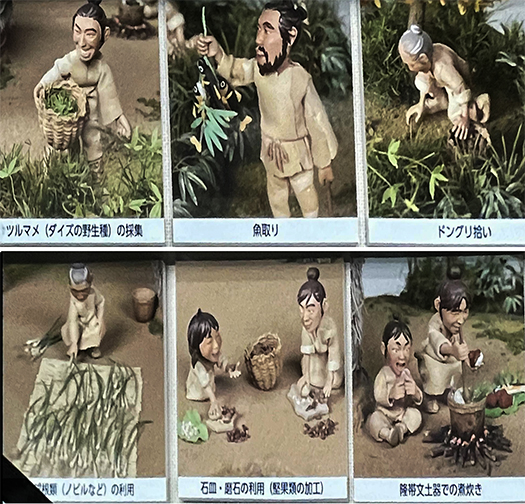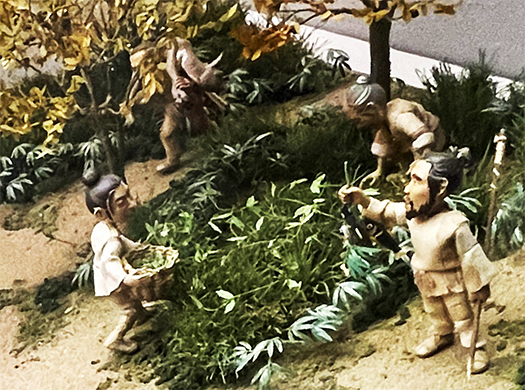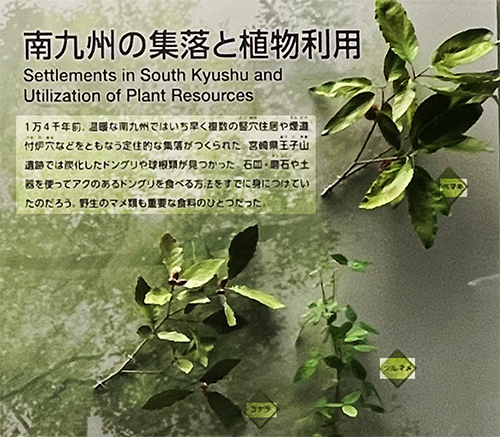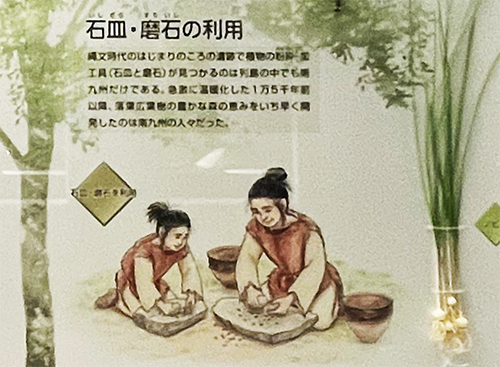

日本列島は周囲を海に囲まれるウォーターフロントと高峻な山岳地形。
国土面積は小さいけれど、人類の居住環境として考えれば
前面の海または河川の水辺と、後背の照葉樹林という環境は
非常に恵まれていたのではないかと思える。
他の地域、東アジアの大陸地域・中国などではいち早く農耕が始まるけれど
見方を変えれば日本列島ではそうなる強い必然性がなかったとも思える。
大型動物種が狩猟によって徐々に減少していったのに対応して
より小動物種を獲得する弓矢が発達していくけれど、
基本的な動物タンパク源は水辺での魚類がメインになっていったのでしょう。
そして気候の温暖化にともなってウォーターフロントに沿って
大きく広がった照葉樹林帯からの多様な植物性栄養源の摂取習慣が強まった。
まさに「海の幸、山の幸」という環境。
日本列島の民話に特徴的な2元論の素地が広範に広がったのだろう。
こういう生活実相が広く、そして永く列島社会では続いたのだと思う。

図は「南九州の集落と植物利用」というパネル。以下文章説明。
〜14,000年前、温暖な南九州ではいち早く竪穴住居や煙道付き炉穴などを伴う
定住的な集落が作られた。宮崎県王子山遺跡では炭化したドングリや球根類の発見。
石皿・磨石や土器を使ってアクのあるドングリを食べる方法をすでに身に付けていた。
野生のマメ類も重要な食料のひとつだった。〜

〜石皿・磨石の利用。縄文のはじめ頃の遺跡で植物の
「粉砕・加工具〜石皿・磨石」が見つかるのは列島の中でも南九州だけ。
急激に実現した温暖化に伴う落葉照葉樹の豊かな森のめぐみを
いち早く「開発」したのは南九州の人々だった。〜
植物栄養源を経口摂取可能なように「工夫」していくという思惟作業が
列島人に特徴的なこころ、大きな精神領域を形成していったと想像できる。
丹念に採取経験を積み重ねて原料を確保し、それに多段階の加工工程を加える。
食物獲得にあたってこのような繊細な作業を繰り返す心的運動性。
日本人の精神性のどこかにDNA的に仕舞い込まれていると思える。
ものづくりの基盤的思考性に関わっているように思えるのです。
人類と摂取栄養源との関係での精神文化性。
地球上の他の地域とは大きく相違するかなり特殊な環境が列島にはあった。
イラスト表現されたような母と娘の相伝で伝わってきた食物創造の営為に、
なにか深く癒される精神性を感じさせられるものがある。
旧石器時代の「ばっかり食」習慣から進化発展した多様な食習慣。
照葉樹の森がわたしたちの精神性を育んだ最大の根源なのではないか。
こういう部分に強いルーツ感がただよってくる。・・・
English version⬇
Food Diversity in Evergreen Forests: The 37,000-Year History of the Japanese Archipelago – 15
The food materials of the broadly spread broadleaf forests. The food materials of the ever-expanding evergreen forests were discovered and transformed into food through a series of complex and exquisite processing efforts. The basis of thinking for manufacturing ingenuity. Food Diversity
The Japanese archipelago has a waterfront surrounded by the sea and steep mountainous terrain.
Although the land area is small, when considered as an environment for human habitation
The Japanese archipelago is small in terms of land area, but as a habitat for human beings, it is thought to have been extremely blessed with a waterfront environment of oceans and rivers in the foreground
and the terrestrial forests in the rear must have been very blessed.
In other regions, such as continental East Asia and China, agriculture began early.
In other regions, such as continental East Asia and China, agriculture began early, but there was no strong necessity for this to happen in the Japanese archipelago.
In response to the gradual decline of large animal species through hunting
The basic source of animal protein was water.
The basic source of animal protein was probably fish from the waters.
And as the climate warmed, the area along the waterfront
The warming of the climate has led to an increase in the intake of a variety of plant sources of nutrition from the broad expanse of broadleaf forests along the waterfront.
This is truly a “food from the sea, food from the mountains” environment.
The dualism characteristic of Japanese folklore must have spread over a wide area.
I believe that this type of lifestyle continued to prevail in the archipelago for a long time.
The figure is a panel titled “Settlements and Plant Use in Southern Kyushu”. The following is a textual explanation.
〜In the warm climate of southern Kyushu, settled settlements with pit dwellings and furnace pits with flue were established as early as 14,000 years ago.
Settlements with pit dwellings and furnace pits with flue were established in the warmer southern Kyushu region ~14,000 years ago. Carbonized acorns and bulbs were discovered at the Ojiyama site in Miyazaki Prefecture.
The people had already learned how to eat acorns with their acrid taste using stone plates, polished stones, and earthenware.
Wild legumes were also an important food source. ~.
~Use of stone plates and polished stones. Only in Southern Kyushu in the archipelago can one find “crushing and processing tools – stone plates and polished stones
Only in Southern Kyushu in the archipelago can one find “crushing and processing tools – stone plates and polished stones.
It was the people of Minami-Kyushu who were the first to “develop” the rich forests of deciduous evergreen trees that accompanied the rapid warming of the earth.
It was the people of Minami-Kyushu who were the first to “develop” the richness of deciduous evergreen forests that accompanied the rapid global warming. ~.
The thought process of “devising” plant nutrient sources that can be taken orally
The thought process of “devising” plant nutrition sources that could be ingested orally formed the unique mind of the archipelago’s people, and a large spiritual realm.
The process of obtaining raw materials through careful collection and experience, and then adding multiple processing steps to the raw materials.
This is the mental motility that repeats such delicate work in acquiring food.
It seems to be embedded somewhere in the DNA of the Japanese mentality.
It seems to be involved in the fundamental thinking of monozukuri.
The psychocultural nature in relation to the human race and the nutritional source of intake.
The archipelago had a rather unique environment that differed greatly from the rest of the earth.
The practice of food creation, which has been handed down from mother to daughter, as illustrated in the illustration, has a deeply healing spirituality.
There is something deeply healing about the spirituality of the food creation activities handed down from mother to daughter, as illustrated in the following illustration.
The diverse food customs that evolved from the “binge-eating” habits of the Paleolithic period.
I believe that the terrestrial forests are the greatest root from which our spirituality has been nurtured.
This is where I feel a strong sense of rootedness. The roots of our roots are strong in this part of the world.
Posted on 11月 15th, 2022 by 三木 奎吾
Filed under: 日本社会・文化研究, 歴史探訪







コメントを投稿
「※誹謗中傷や、悪意のある書き込み、営利目的などのコメントを防ぐために、投稿された全てのコメントは一時的に保留されますのでご了承ください。」
You must be logged in to post a comment.